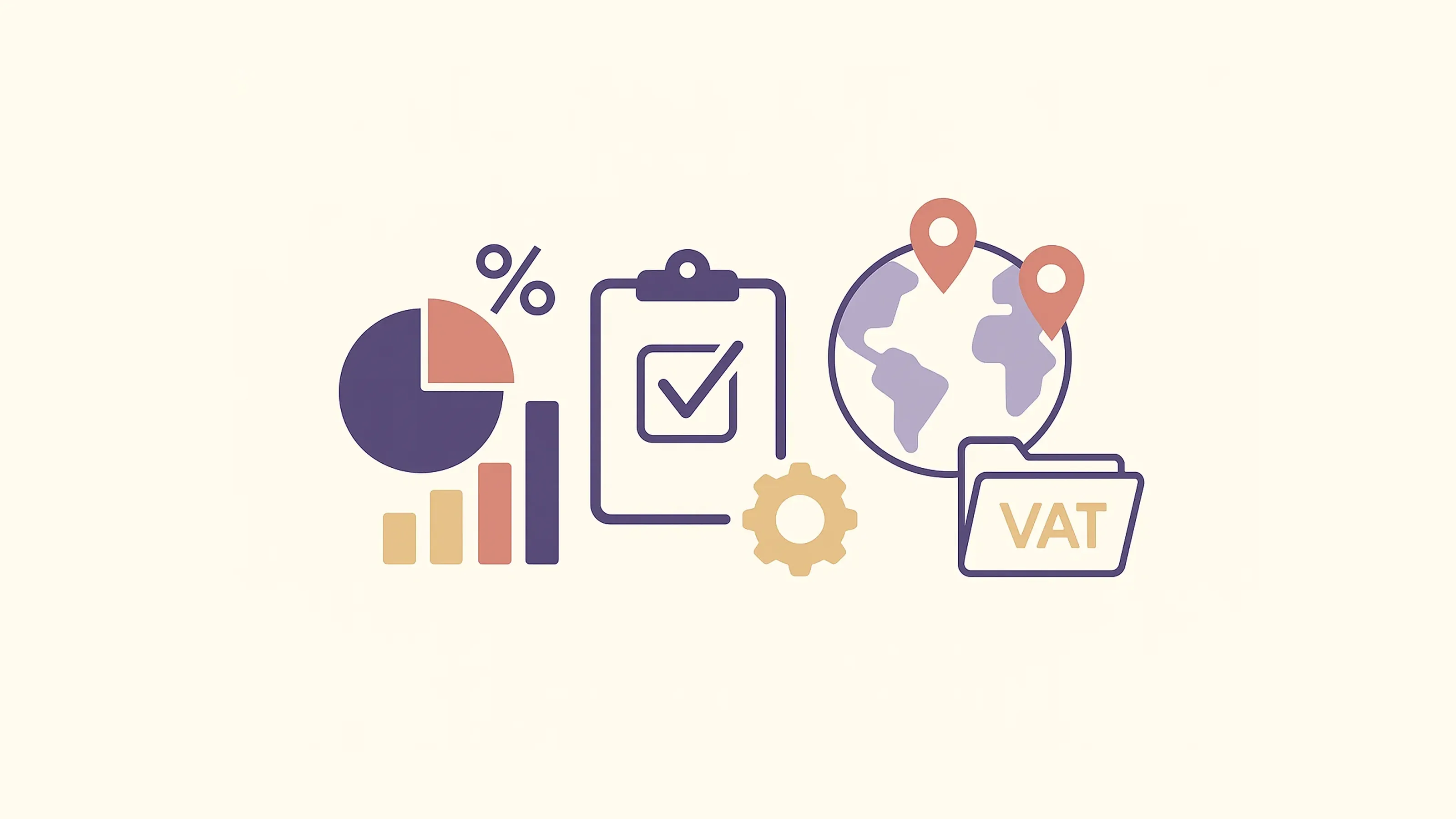International Sales Tax: 7 Simple Steps to Get Compliant
International sales tax is becoming increasingly complex as global e-commerce continues to expand. According to Statista, global retail B2C e-commerce sales are expected to reach $4.12 trillion, driven by major platforms like Amazon, Alibaba, and eBay. As more transactions cross borders, tax authorities worldwide are tightening enforcement. Registering for sales tax in the right jurisdictions is essential to remain compliant and avoid penalties. This guide breaks down a simple 7-step framework to help you navigate international tax rules, streamline VAT filings, and scale your business with confidence.
Step 1: Grasp the Evolving Sales Tax Landscape
Global consumption taxes (VAT, GST, or sales tax) generate trillions in annual revenue.
According to the OECD, over 57% of cross-border e-commerce transactions are processed through major digital platforms like Amazon and Alibaba, rather than seller websites. This shift has driven governments to tighten tax oversight:
- In the European Union, the OSS/IOSS systems collected €33 billion in VAT in 2024, up from €26 billion in 2023.
- Since their launch, these systems have enabled the collection of nearly €88 billion in VAT across the EU.
- More than 170,000 sellers are now registered across the Union OSS, IOSS, and non-Union OSS schemes.
These figures highlight the growing need for strong tax compliance processes - regardless of company size. Your role is to identify where your business triggers tax obligations, handle registration, and track filings accurately. For companies selling across borders, working with reliable sales tax advisory services can simplify complexity and minimize risk.
For deeper insights into global compliance strategies, explore the Global Sales Tax Solutions & VAT Compliance Guide.
Definition of International Sales Tax
International sales tax is a consumption-based levy imposed by different jurisdictions on goods and services crossing borders. Each country (or state/province) has unique rules on when and how businesses must collect, report, and remit these taxes.
Step 2: Pinpoint Where You Need to Register

“Registering for sales tax” means determining where your business has tax nexus. You may need to register if:
- You store inventory locally (e.g. Amazon FBA)
- You exceed a country’s sales threshold
- You have staff or physical presence
In the EU, sellers must register once annual cross-border B2C sales exceed €10,000, under the Union OSS rules. In the US, most states enforce economic nexus starting at $100,000 or 200 transactions (OECD). Other markets like Canada or Australia apply similar rules for non-resident sellers.
For US-based sellers expanding globally, review the particular requirements in VAT services for US companies: How to Stay Compliant When Selling Internationally.
Step 3: Explore Sales Tax Advisory Services
Managing international registrations often requires expert help. That’s where sales tax advisory services step in - helping you stay compliant across borders, save time, and reduce risk.
These specialists assist with:
- Registering for sales tax in multiple countries or U.S. states.
- Interpreting local VAT/GST regulations and thresholds.
- Preparing documentation in local languages.
- Automating deadline tracking and report submission.
In the EU, the Commission recommends using professional help when managing cross-border VAT obligations European Commission. In the U.S., the IRS recognizes enrolled agents and CPAs as authorized professionals for multi-state tax support.
If you’re seeking personalized strategy and expert guidance, explore VAT Consulting for International Businesses for more resources and advice.
Creating a Centralized Document Vault
Storing everything in one secure folder makes the process faster. Keep copies of your completed forms, local government communications, and official certificates. If you have employees or agents abroad, ensure they know where to find reference documents and confirm details accurately.
Step 4: Gather Essential Information for Registration
Once you know where you need to register, prepare the key documents most jurisdictions require. This helps avoid delays and ensures smooth approval.
You’ll typically need:
- Company legal name, address, and incorporation details
- Business ID numbers (e.g. VAT ID, EIN, or national equivalents)
- Estimated or actual revenue in the target country
- Description of products or services you plan to sell
Having this information ready upfront makes registering for sales tax faster and more efficient across multiple regions.
Creating a Centralized Document Vault
Storing everything in one secure folder makes the process faster. Keep copies of your completed forms, local government communications, and official certificates. If you have employees or agents abroad, ensure they know where to find reference documents and confirm details accurately.
Step 5: Adapt Your E-Commerce Systems
Marketplaces often collect sales tax, but usually only for domestic orders. For cross-border sales, you need to configure your systems to handle tax correctly.
Make sure to:
- Check who collects tax by platform and region
- Enable automated tax calculation at checkout
- Sync tax settings with your ERP or accounting tools
- Export accurate data for VAT/GST returns
According to the European Commission, over 4.6 billion low-value parcels entered the EU in 2024- about 12 million per day, mostly from Chinese platforms. With volumes this high, automation is essential.
Trusted sales tax advisory services can optimize your setup for global compliance. See how technology can help with Tax Technology Tools – VAT Compliance Automation.
Step 6: Leverage Structured Tools for Reporting
Handling VAT and sales tax reporting across multiple countries requires accuracy, speed, and clear processes. While full automation isn’t always feasible, using structured workflows and expert-led support helps reduce errors and save time - especially at scale.
Key components of an effective reporting setup include:
- Accurate tax calculations per jurisdiction and currency
- Centralized dashboards to track obligations by country or sales channel
- Pre-formatted files tailored to local tax authority requirements
- Deadline tracking systems to avoid late filings and penalties
The Power of Single-Point Contact
Managing tax compliance in multiple jurisdictions manually can be complicated. Ray Grove, a global tax executive, noted that “Tax compliance has become increasingly complex for multinational corporations.” Centralizing your compliance via a single provider - or using a dedicated software suite - simplifies it all. For more on how to digitize your VAT process, check out How to File VAT Returns Online: Streamlining Digital Submission.
Step 7: Monitor Changes and File on Time
Registering is just the beginning - sales tax rules evolve constantly, and staying compliant means staying informed. Even mid-year changes can impact your filings or trigger new obligations.
To stay ahead:
- Subscribe to official updates from tax authorities (e.g. EU Taxation, IRS)
- Track all filing deadlines - monthly, quarterly, or annually
- Review nexus thresholds regularly, especially when expanding to new regions
The 2021 removal of the €22 VAT exemption on low-value imports in the EU is a prime example. It led to a sharp drop in small-parcel imports from China, proving how fast policy shifts affect compliance. Monitoring such changes helps you avoid penalties and protect profit margins.
Conclusion
Navigating International Sales Tax doesn’t have to be a headache. By zeroing in on which markets you serve, bringing professional help when necessary, and automating as much as possible, you’ll reduce risk and free up your energy for growth. Stay informed, meet all deadlines, and keep your records clear. Your business can then seamlessly tap global customers- while staying compliant every step of the way.


